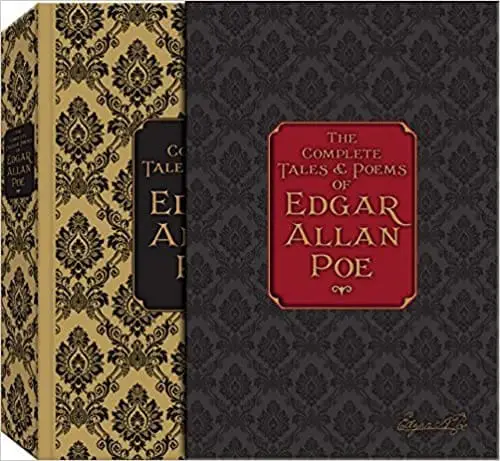Epeolatry Book Review: The Complete Tales and Poems of Edgar Allan Poe

Disclosure:
Our reviews may contain affiliate links. If you purchase something through the links in this article we may receive a small commission or referral fee. This happens without any additional cost to you.

Title: The Complete Tales and Poems
Author: Edgar Allan Poe
Genre: Classic Horror
Publisher: Race Point Publishing
Release Date: 2014 edition
Synopsis:The Complete Tales & Poems of Edgar Allan Poe is the next edition in the Knickerbocker Classic series, featuring works from the famous gothic American writer. His works span from 1827 to his death in 1849. His often macabre and dark works included “The Raven,” “The Black Cat,” “The Tell-Tale Heart,” and “Annabelle Lee.” For Poe fans worldwide, this stunning gift edition has a full cloth binding, foil blocking on the spine, ribbon marker, and is packaged neatly in an elegant slipcase. The Complete Tales & Poems of Edgar Allan Poe contains every known Poe tale ever written, this deluxe edition boasts the entire Poe catalogue.
Edgar Allan Poe holds multiple distinctions as a writer. First, he invented the detective story. Second, he was a superb poet and short-story writer. Lastly, he was the author of some of the most terrifyingly uncomfortable tales ever penned. This isn’t a bad record for someone who wrote of his writing before his premature death at the age of forty, ‘I have no reason to be ashamed’.
This volume contains all the poetry and fiction, making it a great starting point for the reader to enjoy the sheer variety of Poe’s short and long works, and for the writer keen to study in depth the skills required to construct compelling horror, mystery and (occasionally) fantasy fiction.
“The Mystery of Marie Roget”, “The Purloined Letter”, and “The Murders in the Rue Morgue” showcase many traits we would subsequently come to associate with the detective story. The arrogant genius, the amiable sidekick, and the pedestrian investigative skills of the police force were presented together for the first time. It was an intriguing combination that quickly became well established. As a result of Poe’s location choice, a lasting connection exists between Paris and the detective genre, something Agatha Christie cheerfully subverted in her Poirot Mysteries by making her Belgian detective perpetually mistaken for a Frenchman.
The genius that was Poe’s detective fiction may have emerged spontaneously, but his fantasy and horror fiction (particularly the latter) grew out of an existing tradition in a more time-honoured way. The ‘rules’ of gothic fiction had been established, thoroughly explored, and (some might say) finally exhausted in the decades before Poe’s birth in 1809. However, he built upon these conventions to refresh the horror story by adding greater psychological penetration.
“The Fall of the House of Usher” showcases many gothic horror features: an ancient family, a terrible home, secrets long husbanded. To this Poe added the inner dimension: an old friend arrives to witness the decline of Roderick Usher, funneling his inner response to the physical and moral environment in a manner more emotionally accessible to the reader than the focus on external action common in gothic horror.
There’s also a lighter tone to this volume, presented through “The System of Doctor Tarr and Professor Fether”. Poe offers outright bloodthirstiness in stories such as “The Masque of the Red Death”, and psychological torment in “The Pit and the Pendulum”. The outright stories of humour can feel a little forced at times, but this collection ends strongly with “The Narrative of A Gordon Pym”.
5 out of 5 stars.
Enjoy!
- About the Author
- Latest Posts
They are a non-binary writer and reviewer of fantasy and horror fiction. They are a Contributing Editor with Albedo One Magazine and a reviewer with the British Fantasy Society and Schlock! Webzine. Their fantasy novel ‘Dagmar of the Northlands’ is out now on Kindle and Smashwords. They have had short fiction published in many anthologies from small presses and in a number of magazines, including The Horror Zine. They also hold a Postgraduate Certificate in Creative Writing from Newcastle University.











